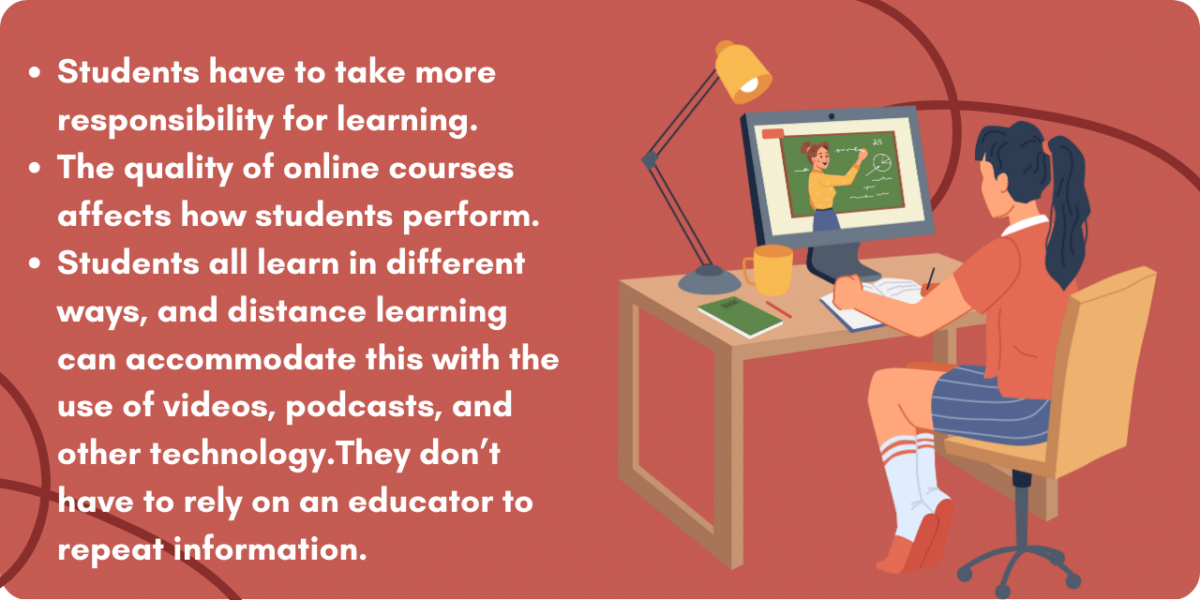In 2020 millions of students around the world were forced into distance learning by the COVID-19 pandemic. This accelerated a trend that was already taking place. There has been tremendous growth in the number of students learning online, and it has proved to be a solution to some educational challenges. The increase in distance learning raises the question of how it impacts students’ academic performance.
A change in negative perceptions about distance learning
The negative perception of distance learning is changing. Students can now work full time and study because they can access online courses and complete them in their own time and at their own pace. If they have time difficulties, they can get assignment help from professional writers.
When students work and study at the same time, they can immediately apply their knowledge in practice which can help to consolidate it. Previous physical barriers that prevented some students from having access to learning are gone, and they can now study at any time and from anywhere.
Advances in technology have offered the means to make distance learning a more immersive experience for students. Websites, mobile phones, laptops, and learning management systems (LMS) are a few developments that enhance distance learning.

Some characteristics of distance learning
- One characteristic that sets distance learning apart is that students have to take more responsibility for learning. They need to self-regulate and have the persistence to pursue their goals.
- The quality of online courses affects how students perform. Courses that are carefully constructed to help students progress in stages are most successful.
- Students all learn in different ways, and distance learning can accommodate this with the use of videos, podcasts, and other technology. Students don’t just have to read the text if they are more visual learners – they can watch a video. They can go back and watch parts of a video over and over if they don’t grasp a difficult concept at first. They don’t have to rely on an educator to repeat information.
Pros of distance learning
Flexibility
Students who are unable to attend traditional colleges or universities can now enroll in online courses. They have access to resources and instructors that may not be locally available.
Learn and earn
Many students who take online courses are already working professionals who want to get ahead in their field.
No geographic boundaries
Students can complete a distance learning course from anywhere. They can choose any school that offers a program they want to pursue. If they want to relocate, they don’t have to worry about transferring to another school.
Save on costs
Distance learning allows students to save on costs such as accommodation, fuel, parking, child care etc.
Learn tech skills
By accessing study material electronically, participating in online forums, and uploading assignments, students learn tech skills. This can help them in their future careers where tech skills are often required.
Cons of distance learning
Lack of physical interaction
Courses often provide ways for students to interact with other students from all over the world in forums, group discussions etc. However, in an online environment, students may feel isolated and miss physical contact with other students.
Language difficulties
Students with language difficulties may have a disadvantage in an online environment that’s text-heavy.
The quality of some online course
Students need to make sure that they earn their online degrees from properly accredited institutions. The quality and validity of the education may be questionable if they don’t do so.
Missing out on campus life
Physical attendance at college or university allows students to live in residence, join clubs, and enjoy the excitement of being part of life on campus.
Not enough accountability
There is more temptation for students to procrastinate when doing distance learning. No one is looking over their shoulder, and they have to follow their own schedules. This requires discipline and motivation.
How distance learning can improve student performance
Evidence to date seems to show that the best types of distance learning can improve how students learn and what they learn and deliver high-quality learning experiences. Students learn how to research, manage their time, learn independently, and problem-solve.
When online learning environments make use of the wide variety of communication tools available, they can provide an interactive, constructive and cooperative experience for students. This may include using components like podcasts, videos, virtual laboratories, and interactive digital games.
The future of distance learning
Mobile-friendly content will be essential as students today often use their mobile devices. Optimizing course content and websites for mobile will increase the use of distance learning programs.
Online programs are likely to become more diversified as educational institutions broaden their online offerings. This may help them to reach whole new sectors of students. Degrees in education and business have always been popular online. Now more students are considering online degrees in various other areas, too, such as IT, STEM, health and medicine.
Hybrid courses that combine distance learning with classroom teaching are becoming increasingly popular. This can give students the best of both worlds. Distance learning is primarily self-directed, but with some support from professors, especially for the more complex aspects of coursework, students who have more difficulty with distance education can succeed.
Conclusion
As you can see, distance learning has both pros and cons. However, it is definitely here to stay, and the pros can outweigh the cons. It is important to choose accredited courses that offer quality material. Courses that use the most up-to-date technologies can provide a most engaging learning experience for students. When learning is interactive and engaging, students are more motivated and can improve their academic performance.
